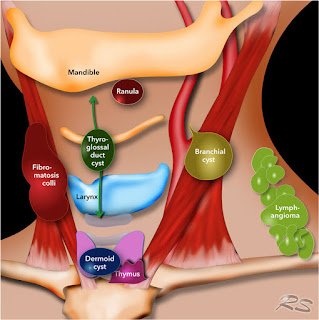What is a dermoid cyst?
A dermoid cyst is a pocket or cavity under the skin that contains tissues normally present in the outer layers of the skin. The pocket forms a mass that is sometimes visible at birth or in early infancy but often is not seen until later years. Dermoid cysts are usually found on the head or neck and face, but can occur anywhere on the body.What causes a dermoid cyst?
A dermoid cyst is a congenital defect (present from birth) that occurs during embryonic development when the skin layers do not properly grow together. A dermoid cyst is lined with epithelium, which contains tissues and cells normally present in skin layers, including hair follicles, sebaceous (skin oil), and sweat glands. These glands and tissues secrete their normal substances which collect inside the cyst, causing it to grow and enlarge.What are the symptoms of a dermoid cyst?
The following are the most common symptoms of a dermoid cyst. However, each child may experience symptoms differently. Symptoms may include a small, often painless, lump in the mid-line of the neck (in which the skin over the lump can easily be moved). The lump may be skin-colored, or may have a slight yellow tinge.The symptoms of a dermoid cyst may resemble other neck masses or medical problems. Always consult your child's physician for a diagnosis.
How is a dermoid cyst diagnosed?
Dermoid cysts are diagnosed by physical examination. Generally, the mass can be easily moved beneath the skin. In addition to a complete medical history and physical examination, diagnostic procedures to determine if the cyst is connected to other tissues in the head and neck may include:-
Computed tomography scan (also called a CT or CAT scan). A
diagnostic imaging procedure that uses a combination of X-rays and
computer technology to produce horizontal, or axial, images (often
called slices) of the body. A CT scan shows detailed images of any part
of the body, including the bones, muscles, fat, and organs. CT scans are
more detailed than general X-rays.
-
Magnetic resonance imaging (MRI). A diagnostic procedure that
uses a combination of large magnets, radiofrequencies, and a computer to
produce detailed images of organs and structures within the body.
Treatment of a dermoid cyst
Specific treatment of a dermoid cyst will be determined by your child's physician based on:-
Your child's age, overall health, and medical history
-
Extent of the condition
-
Your child's tolerance for specific medications, procedures, or therapies
-
Expectations for the course of the condition
-
Your opinion or preference












Δεν υπάρχουν σχόλια:
Δημοσίευση σχολίου